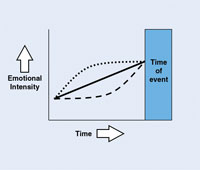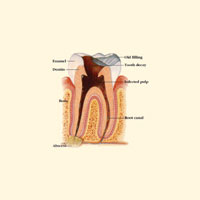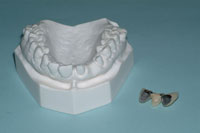What first attracted you to dentistry? Was it the technical procedures, the idea of helping people, or owning your own business? I’ve never had dentists tell me that they went into dentistry because they wanted to manage office staff or figure out workable systems for a dental practice. Whatever it was that caught your attention, it is probably not what you are able to spend all of your time doing today. My guess is, you are probably spending a lot more time than you thought you would managing your technical and administrative staff. You are the main producer, and the income of the practice depends solely on you. When you are not producing dentistry, you are temporarily unemployed. I meet dentists who are burned out because of stress, staff problems, high overhead, and the inability to be productive consistently. The business of dentistry can be very stressful.
I observe dentists and their staff trying to sort through the many myths of practice management. They struggle with what really works and what they hear they should try next. A lot of mistakes are being made. Many of the actions I see being performed are actually holding the practices back and putting up barriers to success. These barriers are blocking practice and team potential, creating extra stress, and putting everyone on an unpredictable production roller coaster. I’m going to show you how to find out where you are and learn where you want to be. Exposing problems and taking control may be easier than you think. This is a 2-part article. I’ll address 5 vital points this month and 5 more in a future issue. I will help you lay a strong foundation for practice success by sharing exact steps for you to follow.
KEEP SCORE
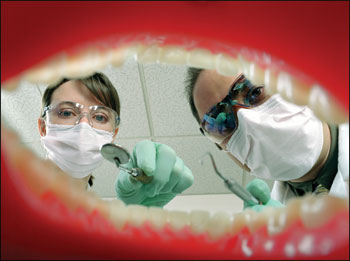 |
|
Table. Suggested Trackers for the Dental Practice. |
|
• Number of New Patients |
Imagine going to watch your favorite football team play, and no one is keeping score. I suspect it wouldn’t be a whole lot of fun. Dental practices should keep score as well. As I consult in practices I see that once we establish benchmarks, the practices tend to stay on track and have consistent income. Production and collections become more predictable.
Trackers serve as gauges, very much like the ones in your automobile, letting you know when to add gas or if you are going too slow and need to pick up speed. They will allow you to have more control by providing information about what is occurring, or not occurring. They will help prevent surprises in all areas of your practice. I’ve seen practices have an increase in production and collections with the single action of implementing the use of trackers. In addition to knowing your numbers, trackers make staff members accountable for their positions. Your computer software accumulates and stores information that will help you find out where you are now (Table).
Trackers make it easy to see what is really happening in your practice. The practice management gauge shown in Figure 1 shows that there is no consistency in the doctor’s production. This is a scheduling problem that needs to be addressed. The best way to track efficiency in the treatment room is to monitor doctor and hygiene production per hour. Efficiency in the treatment room is affected by skill, speed of delivery, and preparation for the procedure. You can determine production per hour by taking the gross production and dividing it by the number of hours worked.
APPOINT THE RIGHT PERSON AS ENGINEER OF YOUR DAILY TREATMENT SCHEDULE
 |
|
Figure 1. Doctor’s production per hour. |
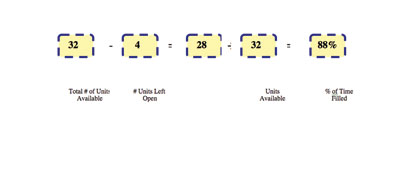 |
|
Figure 2. Calculating percentage of the schedule that is filled. |
 |
|
Figure 3. Tracking percentage of doctor time utilized. |
 |
|
Figure 4. Calculating attainable production targets. |
 |
|
Figure 5. Pretreatment estimates will impair treatment plan acceptance. |
The daily treatment schedule is the heartbeat of all practices. The person creating your day through the schedule will determine your income. This includes the type of house, car, and general lifestyle you have. I know these are strong words, but they are true. In most offices, not enough attention is given to the daily treatment schedule, even though it is one of the most vital actions. If the dentistry is not on the schedule, then you cannot produce it or collect it. Efficient scheduling and effective confirmation skills are essential to maximize clinical production.
In this computer age, several staff members schedule patients throughout the office. We see more and more dental assistants and hygienists scheduling from the treatment room. I have no problem with this, as long as they have had the proper training on scheduling and treatment plans, and are made aware of the need for financial arrangements. The schedule should not be a free-for-all. Without someone appointed as the engineer to oversee and audit the schedule throughout the day, you will have production that roller-coasters, and there will be zero predictability. This causes stress in the practice, patients having to wait, and the schedule to run into lunch and into the evening. You will also have more broken appointments, patients scheduled in the wrong chair, no-shows, and a lower income.
TRACK THE PERCENT OF CHAIR TIME UTILIZED
Tracking the percent of time utilized is the positive approach to seeing how much of your chair time was actually lost in a day. It is time that was never filled and time that opened up due to no-shows or cancellations. The schedule can become more productive by setting goals for the percentage of time filled. Inform your staff members of a goal so that they have guidelines and know what is expected. I like to see the hygiene and doctor schedule no less than 94% filled. This percentage is figured at the end of each day, using the daily treatment schedule. The formula for figuring the percentage of time filled is the same for all providers. The percentages are to be figured separately and monitored daily (Figures 2 and 3).
HAVE A DAILY PRODUCTION TARGET FOR THE OFFICE AND ALL PROVIDERS
If you have no production goals in your practice, then no one really knows what they are trying to ac-complish, and chances are you will not reach your potential. We can be proactive and have a plan, or we can just arrive at the office and wait for the day to happen to us. I have seen the income increase in practices just by setting a target and informing the team.
It becomes a game, and they like to win. Zig Ziglar said, “A goal properly set is half-way reached.” I find this to be true.
Most computer software programs will allow you to incorporate your production target with scheduling so that the dollar amount scheduled will be available at all times. You can easily see how much production has been scheduled at any given time. It is no longer a surprise to learn that you were below target for the day.
You will need a separate target for each provider in the practice; targets are figured for each hygienist and doctor. The formula for figuring an attainable target for each provider is shown in Figure 4. If you are figuring a production target for the first time in an established practice, then you will follow the suggested formula. Start-up practices will not have a history of production, therefore any target would be a guess. These practices will need to take overhead expenses into consideration. The formula outlined in Figure 4 will apply after the practice is a year old.
A target is not something that you should dream up or take out of thin air. It should be based on what has already been achieved in the past. Many times I see the wrong target; it is too high or too low. This becomes frustrating for the doctors and staff, and they begin to ignore it. The practice then suffers and never moves forward. An example would be if a practice never produced more than $2,500 per day and the daily target was $5,000. This is guaranteed to create burnout and take the enthusiasm away.
Targets should be evaluated at the beginning of each year when fees are reviewed and adjusted. Fee increases should be taken into consideration. I have seen practices raise their production target throughout the year every time it was achieved, so their teams never win for long. By following the correct formula, you will have a workable target that will only need to be evaluated once a year. Your staff will enjoy winning, and you’ll be happy with the results.
DO NOT SEND PRETREATMENT ESTIMATES
Pretreatment estimates are a waste of time and nothing more than a delay tactic on the part of insurance companies. The pretreatment estimate takes 4 to 6 weeks to process, and there are no guarantees about what will be paid. By the time you hear from the insurance company and contact the patient, he or she will have conjured up many excuses as to why not to get the treatment. If the patient needs the treatment, then he or she needs to go ahead and schedule it. This becomes easy to handle when your staff members have verbal skills to present treatment plans. All staff should be spreading the same message to your patients.
Our clients report that 78% of pretreatment estimates that are sent to insurance companies are never submitted as a claim (Figure 5). Patients need what they need whether their insurance pays for it or not. We know that insurance companies have barely increased their benefit allowance over the past 40 years. Proper patient education and staff training will eliminate this problem in dental offices.
CONCLUSION
Doctors hear many things through the dental pipeline, and it’s hard to know which systems will help the office run more smoothly and be more profitable. The information shared in this article is just a small part of a much larger system of successful activities for a dental practice. If you start with these changes now, then you will be on your way to reaching your goals.
In a future issue I will be sharing 5 more actions that will help remove barriers to increasing production and practice growth. These vital points are guaranteed to provide less stress in the treatment room and more predictability in your income.
Ms. Pardue is a nationally recognized lecturer and practice management consultant. She has assisted hundreds of doctors with practice expansion and staff development as director of consulting with Classic Practice Resources. For the past 4 years, Dentistry Today has named her a Leader in Dental Consulting. She can be reached at (800) 928-9289, extension 10; sandy@classicpractice.com; or by visiting the Web site classicpractice.com for a free practice analysis.





